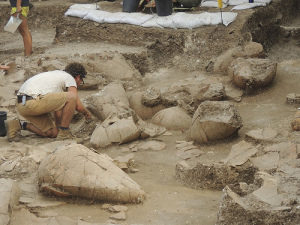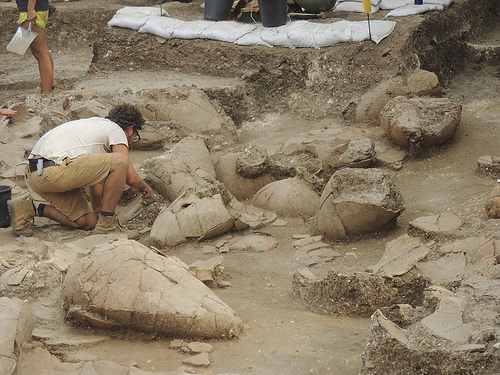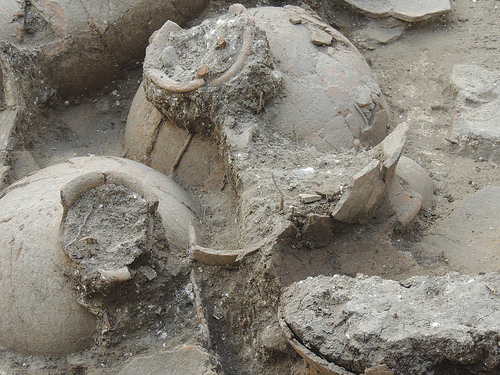
In 2013, while excavating within the palace ruins of Tel Kabri, a 75-acre ancient Canaanite city site in northern Israel that dates back to 1700 BCE, a joint American-Israeli team came across a three-foot-long jar. They later christened it “Bessie.” The single find by itself was nothing remarkable. But they kept digging.
“We dug and dug, and all of a sudden, Bessie’s friends started appearing—5, 10, 15, ultimately 40 jars packed in a 15-by-25-foot storage room,” said excavation co-director Dr. Eric Cline, chair of George Washington University’s Department of Classical and Near Eastern Languages and Civilizations within the Columbian College of Arts and Sciences. “This is a hugely significant discovery—it’s a wine cellar that, to our knowledge, is largely unmatched in its age and size.”
The 40 jars, each of which could have held 50 liters, had a total capacity of about 2,000 liters, meaning the cellar could have held the equivalent of nearly 3,000 bottles of red and white wine. This places the cellar among the largest ancient wine cellars in the world.
The finds were made while they were digging an area adjacent to and west of a monumental building first excavated in 2011, a one-of-kind structure that was lined with precisely-shaped orthostat blocks.
“This is the largest concentration to date of restorable pottery found anywhere in the palace of Kabri and the only place on site where we have found an entire room still full of artifacts,” writes co-director Yasur-Landau and colleagues in their preliminary report. Yasur-Landau is chair of the Department of Maritime Civilizations at the University of Haifa.
They add that it is “the first time that such a storeroom with jars still present has been uncovered within an MB (Middle Bronze Age) palace in Canaan.”
What is more, “the wine cellar was located near a hall where banquets took place, a place where the Kabri elite and possibly foreign guests consumed goat meat and wine,” said Yasur-Landau. “The wine cellar and the banquet hall were destroyed during the same violent event, perhaps an earthquake, which covered them with thick debris of mud bricks and plaster.”
At first, it wasn’t clear that the jars once contained wine. To determine that, Dr. Koh, an assistant professor of classical studies at Brandeis University and associate director of the excavation, analyzed the jar fragments using organic residue analysis. He found traces of tartaric and syringic acids, both key components in wine, as well as compounds suggesting the presence of ingredients popular in ancient wine-making, including honey, mint, cinnamon bark, juniper berries and resins. The recipe is similar to medicinal wines used for 2,000 years in ancient Egypt.
“This wasn’t moonshine that someone was brewing in their basement, eyeballing the measurements,” Dr. Koh said. “This wine’s recipe was strictly followed in each and every jar.”
________________________________
 The team worked in day and night shifts to excavate a total of 40 intact 3,700-year-old vessels in the ancient palatial wine cellar during its six-week dig in July 2013. Courtesy Eric Cline. From Archaeologists Uncover One of Civilization’s Oldest Wine Cellars, Nov. 22, 2013 (Pop. Archaeology)
The team worked in day and night shifts to excavate a total of 40 intact 3,700-year-old vessels in the ancient palatial wine cellar during its six-week dig in July 2013. Courtesy Eric Cline. From Archaeologists Uncover One of Civilization’s Oldest Wine Cellars, Nov. 22, 2013 (Pop. Archaeology)
_________________________________
 Detail view of some of the ancient wine jars unearthed at Tel Kabri. Courtesy Eric Cline. From Archaeologists Uncover One of Civilization’s Oldest Wine Cellars, Nov. 22, 2013 (Pop. Archaeology)
Detail view of some of the ancient wine jars unearthed at Tel Kabri. Courtesy Eric Cline. From Archaeologists Uncover One of Civilization’s Oldest Wine Cellars, Nov. 22, 2013 (Pop. Archaeology)
___________________________________
Now, Koh and colleagues have conducted further organic residue analysis using mass spectrometry. They confirmed that all of the relatively uniform jars contained chemical compounds indicative of wine. Researchers also detected subtle differences in the ingredients or additives within similarly shaped wine jars, including honey, storax resin, terebinth resin, cedar oil, cyperus, juniper, and possibly mint, myrtle, and cinnamon. They suggest the detection of these additives indicates that humans at the time had a sophisticated understanding of plants and skills necessary to produce a complex beverage that balanced preservation, palatability, and psychoactivity. According to the authors of this most recent research study, these results may contribute to a greater understanding of ancient viticulture and the Canaanite palatial economy.
Said Koh, “Based on the nature of the room, it was anticipated from the beginning that residue samples extracted and studied under virtually identical circumstances with minimal variability would have the potential to reveal new and significant insights from both a scientific and archaeological perspective. We believe this study will not only change our understanding of ancient viticulture and palatial social practices, but also the manner in which we approach organic residue analysis (ORA) as an integrated, qualitative, and interdisciplinary exercise that is as field dependent as it is laboratory intensive.”
Wine production, distribution, and consumption are thought to have played a role in the lives of those living in the Mediterranean and Near East during the Middle Bronze Age (1900-1600 BC), but little archaeological evidence about Bronze Age wine is available to support art and documentation about the role wine played during this period, until now.
The study details are published in the open-access journal PLOS ONE at http://dx.plos.org/10.1371/journal.pone.0106406*
____________________________________________
*Koh AJ, Yasur-Landau A, Cline EH (2014) Characterizing a Middle Bronze Palatial Wine Cellar from Tel Kabri, Israel. PLoS ONE 9(8): e106406. doi:10.1371/journal.pone.0106406
Source: Adapted and edited from press releases of the George Washington University and Brandeis University, a previous article published by Popular Archaeology Magazine, Archaeologists Uncover Rare Finds at an Ancient Canaanite Center, and a news release of PLOS ONE, Bronze Age wine cellar found.
____________________________________________
Travel and learn with Far Horizons.
Read about the most fascinating discoveries with a premium subscription to Popular Archaeology Magazine. Find out what Popular Archaeology Magazine is all about. AND MORE:
On the go? Get the smartphone version of Popular Archaeology as an app or as an ebook.
Popular Archaeology’s annual Discovery Edition eBook is a selection of the best stories published in Popular Archaeology Magazine in past issues, with an emphasis on some of the most significant, groundbreaking, or fascinating discoveries in the fields of archaeology and paleoanthropology and related fields. At least some of the articles have been updated or revised specifically for the Discovery edition. We can confidently say that there is no other single issue of an archaeology-related magazine, paper print or online, that contains as much major feature article content as this one. The latest issue, volume 2, has just been released. Go to the Discovery edition page for more information.





